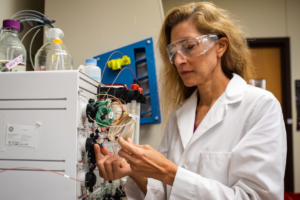“Perception Unfolds: Looking at Deborah Hay’s Dance” will open Feb. 23 at the Blanton Museum of Art at The University of Texas at Austin. The three-month exhibition will present an innovative union of art, dance and technology within a museum setting.
Making its debut at the Blanton, the site-specific video installation combines the groundbreaking choreography of dance pioneer Deborah Hay with new software technologies created to study and inform movement and dance. The resulting artwork four suspended translucent screens on which multiple versions of a single dance are projected offers visitors an opportunity to observe how their individual perceptions of the dancers’ performances, the setting and their own choices as viewers provide insight into the art of choreography.
Hay has likened the experience of looking at contemporary dance to that of regarding contemporary art, as both can be challenging to new audiences. With this in mind, Hay approached the Blanton about the possibility of creating a project that would provide museum visitors with a dynamic new point of entry for engaging with both disciplines. This resulting collaboration builds upon the Blanton’s history of experimenting in the galleries with multidisciplinary programming such as its critically acclaimed “SoundSpace“ series; here Hay brings together a cadre of cross-disciplinary talent, which includes dancers and a choreographer, software developers, a composer, an architect/videographer, a filmmaker and multimedia experts, along with the museum’s own creative staff.
“We are very pleased to collaborate with Deborah Hay on such an important new project,” says Blanton Director Simone Wicha. “This interactive and engaging presentation responds to the most exciting new models in museum programming and furthers our goal of providing innovative and surprising experiences for our visitors. The project’s collaborative spirit also beautifully aligns with a concurrent exhibition of works by Eva Hesse and Sol LeWitt, both contemporaries of Hay and pioneering innovators in their own right.”
The genesis of “Perception Unfolds” was a three-year collaboration between Hay and Motion Bank, an experimental technology research project run by the German-based The Forsythe Company, which was founded by American choreographer William Forsythe. Hay worked with Motion Bank’s team of digital engineers, alongside filmmaker Anna Berger and dancers Ros Warby, Jeanine Durning, and Juliette Mapp, to perform multiple versions of one of Hay’s solos, “No Time To Fly.”
Further fueling Hay’s interest in new technologies, interactive software developer Eric Gould Bear of Austin and artist/videographer Rachel Strickland of San Francisco approached Hay with a new app they had developed that allows users to experiment with roving perspective, engaging spatial memory, and navigating and orienting oneself among multiple video streams. In the resulting creative collaboration at the Blanton, visitors choose how to frame the dance by actively varying their own perspectives on it. As they move in and around the installation, beckoned by its sights and sounds, they perceive overlapping images, gestures that seem to respond to one another, and the effective dematerialization of the boundaries between dancer and viewer.
Deborah Hay, the Blanton and “Perception Unfolds” is the subject of an upcoming episode of the Emmy Award-winning series, “Arts in Context” on PBS. Look for it in winter 2014.
“Perception Unfolds: Looking at Deborah Hay’s Dance” is organized by the Blanton Museum of Art.
Funding for the exhibition is provided in part by Jeanne and Michael Klein in honor of Annette DiMeo Carlozzi and by the Berman Family Foundation.
About Deborah Hay
Deborah Hay was born in Brooklyn in 1941. In the early 1960s, she moved to Manhattan where she trained as a dancer with Merce Cunningham and Mia Slavenska and was a member of the Judson Dance Theater, one of the most radical and explosive postmodern 20th-century art
movements. By 1967 Hay had already achieved prominent status as a young choreographer, and her unique style began to emerge as a distinct voice within the aesthetics of Judson. She left New York in 1970 to live in a community in northern Vermont; six years later, Hay relocated to Austin, Texas, and has been based here ever since. She has toured extensively in Europe and Australia, has choreographed for The Forsythe Company and the White Oak Dance Project, among others, and has performed her works at the Museum of Modern Art, The Menil Collection and the Walker Art Center. Hay is the recipient of the prestigious BAXten Award as well as a Bessie award, among others. In 2009, she received an honorary degree from the Theater Academy in Helsinki, Finland, and in 2012, she became one of 21 American performing artists to receive the inaugural and groundbreaking Doris Duke Artist Award.




